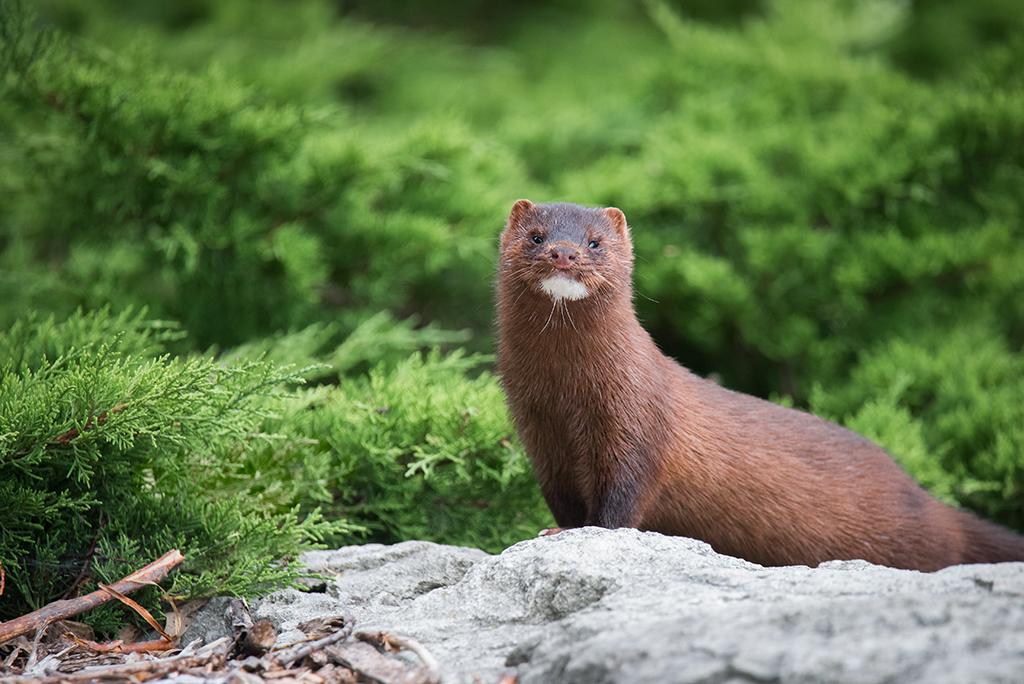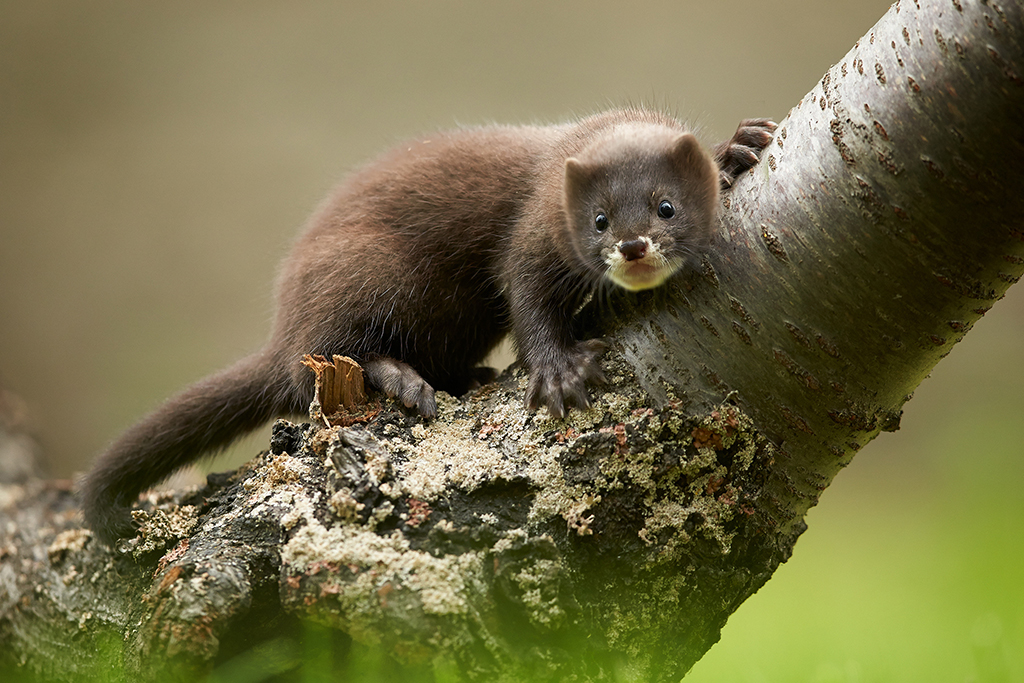Mink are not cute and they’re not cuddly – this is one alien invader our indigenous wildlife could happily live without.
At the time of Neanderthal man, animal skins were worn as a necessity against the elements. Indeed, without them life would have been well nigh impossible.
These days, attitudes towards wearing fur clothing change like the weather, and have an almost unique ability to polarise opinion.
The American mink, a member of the mustelid family, has long been recognised as one of the ultimate fur-bearing animals. It was imported to Britain at the end of the 1920s to be farmed specifically for its luxuriant, soft pelt.
In captivity, a good diet and no threat of predation meant the animals produced the finest skins. Mink could be bred for colour variation, so coats and stoles of rich creams, greys and soft browns were also made, together with the more familiar dark browns and blacks. Mink fur coats have always been a status symbol.
Worn by the chicest, richest and most fashionable, the desire for a mink fur coat, and the high value such a garment fetched, meant that by the 1950s there were mink farms all over Scotland.
Unfortunately, the escapology skills of the mink were vastly underestimated. Many broke loose, and animal rights activists illegally released hundreds more. While they believed that mink farming was cruel, and wearing fur unethical, their ignorant actions led to devastation in the countryside as the escapees murdered small birds and mammals on sight.
Ironically, what had been seen as an act of humanity ended up being the ultimate cruelty. Our native wildlife has suffered ever since. As early as 1956 mink were breeding in the wild, and by the end of the 1960s they were rife in many parts of Scotland, expanding their range from the lowlands to the Outer Hebrides.
The last Scottish fur farm closed in 1993 and Holyrood banned fur farming in 2002, but by then the damage had already been done.

Partially aquatic and equally at home in salt and fresh water, mink breed once a year and raise up to six kits (in captivity they often produce far larger litters), which in turn breed at a year old. They have a scent gland under their tail that emits a powerful odour, and distinctive spraint left prominently on rocks, stumps and jetties also confirms their presence.
I’ve often seen mink on the seashore as well as on the riverbank, foraging for a succulent meal of shellfish, fish and crustaceans in rock pools. They race along with typical bounding mustelid gait and are occasionally mistaken for otters, although they bear little resemblance to them; even the largest mink are far smaller.
Opportunists that hunt by day and night, mink are swift on land, efficient arboreal acrobats and Olympic-class swimmers. They kill ground-nesting species, game, poultry and rabbits, and take fish up to a considerable size.
They enjoy eggs and amphibians, and relish nothing more than the young of waterfowl. Species such as goldeneye, wigeon, moorhen and many shorebirds have suffered as a result of mink depredations. The mink has also led to a dwindling population of moorland birds, with the curlew, lapwing and golden plover all very vulnerable. They also cause devastation in seabird colonies, fisheries and hatcheries.
Despite concrete evidence that mink are invasive aliens that should be obliterated at all costs, they still have their supporters. These people believe that it is not the mink’s fault that it is here in the first place and it should therefore be left alone and naturalised. The same argument is often also applied to the grey squirrel, another alien and unwanted mammal.
The water vole gained literary fame as the much-loved Ratty in Kenneth Graham’s The Wind in the Willows. Despite his name, Ratty was actually a water vole, the largest member of the vole family and now one of Scotland’s most endangered mammals. When I came to our small farm in Perthshire 11 years ago, there was a healthy population living on the burn, clearly apparent from their well-worn runs and latrine sites.
Sometimes I could sit by the burn and hear frenetic vegetation chomping or a distinctive plop’ as a vole went into the water. With its thick fur and special skin flaps to keep ears watertight, this vole is totally geared up for an aquatic lifestyle.
But now, due to mink, there are very few of these charming animals left, except in areas where war has been waged on mink. It is some time since I saw signs of them on our burn and there are major concerns that if mink are not eradicated altogether then the water vole will disappear.
In some parts of northern Scotland, especially the Cairngorms, the once prolific numbers of the darker subspecies of water vole have plummeted so drastically that a massive mink cull is now underway.

It was a still summer’s afternoon when I heard a high-pitched contact call coming from the burn near my house. Creeping over to have a closer look I crouched down and peered into the old mill lade. The noise continued, becoming agitated and urgent, almost as if distressed.
I lay on the wall alongside the burn, scanning the bank. Then I saw a perky, dark chocolate-coloured face with a small white bib at its neck on the other side of the culvert that runs under our drive. It vanished in a flash but I remained motionless until three gleaming, incredibly beautiful and almost black kits floated effortlessly past, in a line just a couple of feet from my face and disappeared into the culvert.
The sight made my blood run cold. I feared for the yellowhammers raising chicks in a scrubby bush just a few yards away, I feared for our few remaining water voles, and I thought of the hens in their run. I set two mink traps, as I often do, but caught nothing and hoped they had moved on to be trapped on the Tay.
Scottish Natural Heritage are working with other organisations and landowners to clear river catchment areas by using specialised trappers and mink rafts, with many country people now so concerned that they are volunteering to help. The presence of mink is easily confirmed by using floating rafts with a covering of clay on their surface where spore can be seen. Setting a trap on a nearby riverbank usually bears fruit because mink, like all mustelids, are highly inquisitive and therefore usually easily caught.
The Hebridean Mink Project has been trapping since 2001 to remove mink from the Western Isles and appears to have been very successful. Thanks to this work, the increasingly rare dunlin, and the other waders that breed on the machair, can now nest in peace.
Mink may be beautiful, and possess fabulous skins that have spawned an entire fashion industry, but there is now such a stink about mink that there is simply no argument for allowing them to survive in the wild in Scotland. If we want to preserve a healthy population of our smaller native creatures, the mink must be eradicated – and the sooner, the better.
(This feature was originally published in 2011)
TAGS

